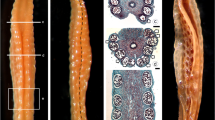Abstract
When inoculated with the dimorphic smut fungus Microbotryum violaceum (Pers.) G. Deml and Oberwinkler, the female flower of the dioecious plant Silene latifolia (Miller) E.H.L. Krause develops anther-like structures filled with spores instead of pollen grains. Using natural scanning electron microscopy, Nomarski interference microscopy, and fluorescence microscopy, we investigated the morphological modifications of the host plant resulting from this parasitism and the localization of smut hyphae in the flower bud. Flowers of infected plants lasted significantly longer than those of healthy plants, probably because the infection strengthened floral organs, such as the flower base and the anther filaments. Smut hyphae were observed throughout all organs of the young flower buds of infected plants, including sepals, petals, stamens, and pistil primordia. In healthy female flowers, anthers initiated sporogenous cell formation, but lacked parietal cell layers. By contrast, the parietal cell layers of infected female flowers differentiated into tapetal tissue, middle cell layers, and endothecial layers, as in the anthers of healthy male flowers. Smut spore formation in the infected anther was initiated in intercellular regions between the sporogenous cells, resulting in degeneration of premature sporogenous cells, tapetal tissue, and middle cell layers. The development of the endothecial layers and epidermis in the infected anther were morphologically normal.








Similar content being viewed by others
Abbreviations
- DAPI:
-
4′,6-diamidino-2-phenylidole
- i:
-
infected
- PMC:
-
pollen mother cell
References
Altizer SM, Thrall PH, Antonovics J (1997) Vector behavior and the transmission of anther-smut infection in Silene alba. Am Mid Nat 139:147–163
Audran JC, Batcho M (1980a) Ustilago violacea (pers) rouss localization in the vegetative tissue of Silene dioica (L.) Clairv. Ann Phytopathol 12:45–55
Audran JC, Batcho M (1980b) Infrastructural aspects of alterations in Silene dioica anthers infected by Ustilago violacea. Can J Bot 58:405–415
Audran JC, Batcho M (1981) Microsporogenesis and pollen grains in Silene dioica (L.) Clairv and alterations in its anthers parasitized by Ustilago violacea (pers) rouss (Ustilaginales) Acta Soc Bot Pol 50:29
Audran JC, Batcho M (1982) Behavior of Ustilago violacea (pers) rouss in vegetative and reproductive tissues of Silene dioica (L.) Clairv. Agronomie 2:784–784
Batcho M, Audran JC (1981) Sporulation of Ustilago violacea in ovules of Silene dioica Phytopathol Z 101:72–79
Donnison IS, Siroky J, Vyskot B, Saedler H, Grant SR (1996) Isolation of Y chromosome-specific sequences from Silene latifolia and mapping of male sex-determining genes using representational difference analysis. Genetics 144:1893–1901
Farbos I, Oliveira M, Negrutiu I, Mouras A (1997) Sex organ determination and differentiation in the dioecious plant Melandrium album (Silene latifolia): a cytological and histological analysis. Sex Plant Reprod 10:155–167
Farbos I, Veuskens J, Vyskot B, Oliveira M, Hinnisdaels S, Aghmir A, Mouras A, Negrutiu I (1999) Sexual dimorphism in white campion: Deletion on the Y chromosome results in a flora asexual phenotype. Genetics 151:1187–1196
Fischer GW, Holton CS (1957) Biology and control of the smut fungi. The Ronald Press, New York
Goldberg RB, Beals TP, Sanders PM (1993) Anther development: basic principles and practical applications. Plant Cell 5:1217–1229
Grant SR, Hunkirchen B, Saedler H (1994) Developmental differences between male and female flowers in the dioecious plant Silene latifolia. Plant J 6:471–480
Heslop-Harrison J (1972) Sexuality of angiosperms. In Steward FC (ed) Physiology of development: from seeds to sexuality, vol VIC. Academic Press, New York, pp 133–271
Lardon A, Georgiev S, Aghmir A, Le Merrer G, Negrutiu I (1999) Sexual dimorphism in white campion: complex control of carpel number is revealed by Y chromosome deletions. Genetics 151:1173–1185
Law TF, Lebel-Hardenack S, Grant SR (2002) Silver enhances stamen development in female white campion (Silene latifolia [Caryophyllaceae]). Am J Bot 89:1014–1020
Lebel-Hardenack S, Hauser E, Law TF, Schmid J, Grant SR (2002) Mapping of sex determination loci on the white campion (Silene latifolia) Y chromosome using amplified fragment length polymorphism. Genetics 160:717–725
Linnaeus C (1737) Hortus Cliffortianus. Amsterdam
Martinez-Espinoza AD, Garcia-Pedrajas MD, Gold SE (2002) The Ustilaginales as plant pests and model systems. Fungal Genet Biol 35:1–20
Matsunaga S, Kawano S (2001) Sex determination by sex chromosomes in dioecious plants. Plant Biol 3:481–488
Negrutiu I, Vyskot B, Barbacar N, Georgiev S, Moneger F (2001) Dioecious plants. A key to the early events of sex chromosome evolution. Plant Physiol 127:1418–1424
Scutt CP, Li T, Robertson SE, Willis ME, Gilmartin PM (1997) Sex determination in dioecious Silene latifolia. Effects of the Y chromosome and the parasitic smut fungus (Ustilago violacea) on gene expression during flower development. Plant Physiol 114:969–979
Shykoff JA, Bucheli E, Kaltz O (1996) Flower lifespan and disease risk. Nature 379:779
Vánky K (1998) The genus Microbotryum (smut fungi). Mycotaxon 67:33–60
Vánky K (2002) Illustrated genera of smut fungi. The American Phytopathological Society, St. Paul, MN
Warmke HE (1946) Sex determination and sex balance in Melandrium. Am J Bot 33:648–660
Werth E (1911) Zur Biologie des Antherenbrandes. Arb Kais Biol Anst Land Forstwirtsch 8:427–450
Westergaard M (1958) The mechanism of sex determination in dioecious flowering plants. Adv Genet 9:217–281
Ye D, Oliveira M, Veuskens J (1991) Sex determination in the dioecious Melandrium. The X/Y chromosome system allows complementary cloning strategies Plant Sci 80:93–106
Young HJ (2002) Diurnal and nocturnal pollination of Silene alba (Caryophyllaceae). Am J Bot 89:433–440
Acknowledgments
The authors thank Dr. Sarah R. Grant and Ms. Theresa F. Law for the generous gifts of S. latifolia seeds and advice on infection methods. This work was supported by Grants-in-Aid of Scientific Research to S.K. (No. 13016022) and S.M. (No. 13740469) from the Japanese Ministry of Education, Science, and Culture, and by Research for the Future from the Japan Society for the Promotion of Science.
Author information
Authors and Affiliations
Corresponding author
Rights and permissions
About this article
Cite this article
Uchida, W., Matsunaga, S., Sugiyama, R. et al. Morphological development of anthers induced by the dimorphic smut fungus Microbotryum violaceum in female flowers of the dioecious plant Silene latifolia . Planta 218, 240–248 (2003). https://doi.org/10.1007/s00425-003-1110-8
Received:
Accepted:
Published:
Issue Date:
DOI: https://doi.org/10.1007/s00425-003-1110-8




